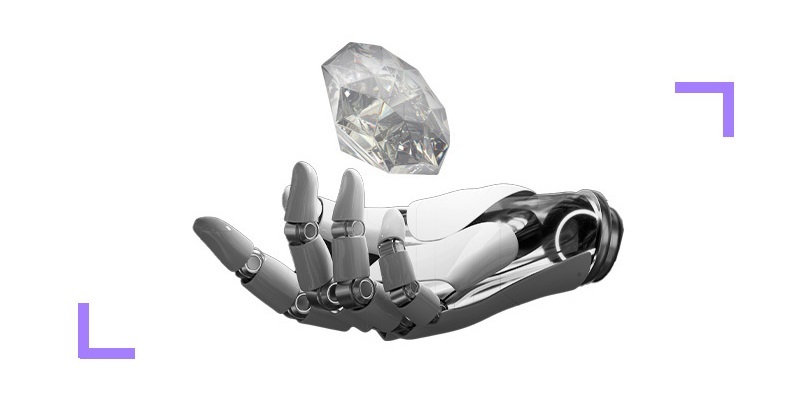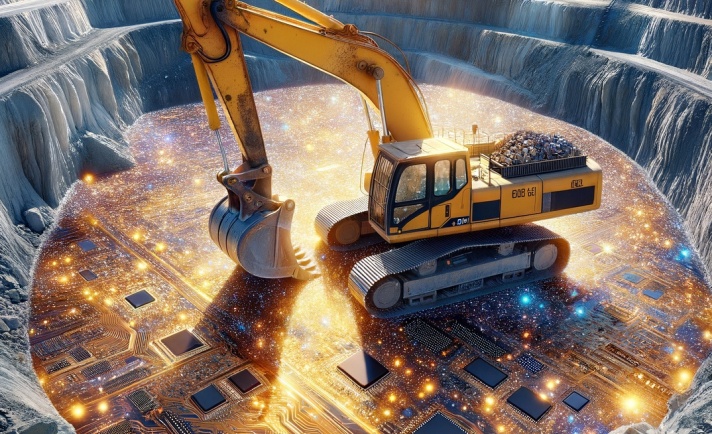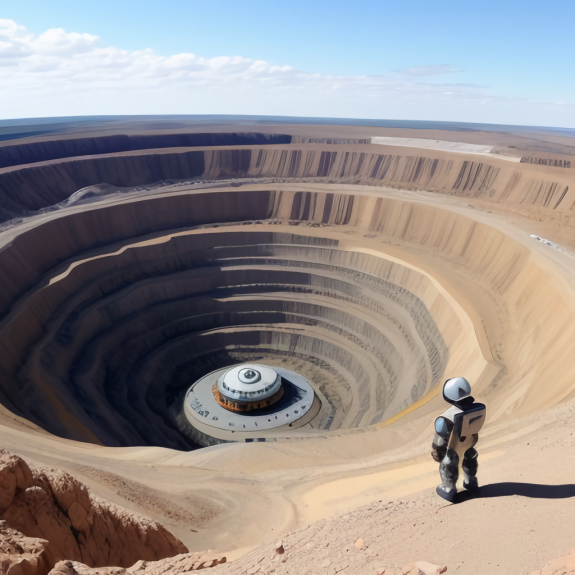Current & Future Role of AI in Mining

The mining industry is undergoing a transformative shift due to the integration of Artificial Intelligence (AI) and automation, moving from traditional methods to technologically advanced approaches. AI and automation promise increased efficiency, enhanced safety, and reduced environmental impact. Key innovations include AI-driven predictive maintenance, machine learning for optimizing resource extraction, and autonomous machinery like vehicles and drones that perform hazardous tasks. These technologies are essential for maintaining competitiveness and sustainability in the global market.
The transition to AI and automation in mining demands a rethinking of workforce training, ensuring employees can collaborate with advanced systems. This shift encourages a culture of innovation, promoting new technologies and processes that drive long-term growth and sustainability. However, the ethical and social implications must be considered. Ensuring transparency, fairness, and accountability in AI applications is crucial for public trust and societal acceptance. Involving local communities and stakeholders in decision-making helps mitigate adverse impacts and ensures equitable sharing of technological benefits.
In fact, AI and automation are revolutionizing the mining industry, bringing numerous benefits while also presenting challenges that need careful management to achieve sustainable and inclusive growth. This article delves into the multifaceted impact of AI and automation on the current and future of mining, exploring their applications, benefits, challenges, and implications for the industry at large.
AI in Current Mining Industry
The mining industry is undergoing a technological revolution, driven by advancements in AI and automation. These technologies are transforming various aspects of mining, from exploration to processing, enhancing efficiency, safety, and sustainability. This comprehensive essay delves into the current applications of AI and automation across different stages of mining operations. We will also examine specific examples of mining companies around the world that are leveraging these technologies.
1. Role of AI in Mining Operations
AI plays a crucial role in mineral exploration by analyzing geological data to predict ore deposits more accurately. Traditional exploration methods involve significant guesswork and manual analysis, which are time-consuming and often inefficient. AI and machine learning algorithms can process vast amounts of geological data, identifying patterns and correlations that may not be evident to human geologists.
Goldspot Discoveries, a Canadian technology company, uses AI to improve the accuracy and efficiency of mineral exploration. Their AI platform analyzes geological, geochemical, and geophysical data to identify potential exploration targets. This approach has led to significant discoveries and optimized exploration strategies, reducing the time and cost associated with finding new mineral deposits. Likewise, Rio Tinto, one of the world's largest mining companies, has adopted AI for exploration activities. By using machine learning algorithms, Rio Tinto can predict the location of mineral deposits with greater precision. This has been particularly effective in their exploration for copper, allowing them to streamline the exploration process and focus efforts on the most promising areas.

1.1 Mineral Exploration
1.2 Mineral Exploitation
In the extraction phase, AI enhances the efficiency and safety of drilling, blasting and transportation operations. Automated drilling systems, guided by AI algorithms, can optimize drilling patterns and adapt to changing conditions in real-time. This results in more precise drilling, reduced operational costs, and minimized environmental impact.
BHP, a leading global resources company, utilizes autonomous drills at its iron ore mines in Western Australia. These drills, operated by AI, can work 24/7 without human intervention, significantly increasing productivity and safety. The AI systems optimize drilling patterns and make real-time adjustments based on geological conditions, ensuring efficient resource extraction. Anglo American also has implemented smart drilling technology across its operations. AI-driven systems analyze data from drilling sensors to optimize the drilling process, reducing energy consumption and improving accuracy. This technology has been particularly beneficial in their copper and platinum group metals (PGM) mines, where precise drilling is critical for efficient extraction.
Blasting is a critical part of mining that can benefit greatly from AI. Precision in blasting operations can minimize waste, reduce environmental impact, and improve safety. AI algorithms can analyze geological data to design optimal blast patterns, ensuring efficient fragmentation of the rock and minimizing the use of explosives.
Orica, a leading supplier of explosives and blasting systems, has developed BlastIQ, an AI-driven blast optimization platform. Used in various mines globally, BlastIQ integrates data from drill holes, rock properties, and previous blasts to design precise blast patterns. This technology has improved blasting efficiency and reduced the environmental impact of mining operations. Likewise, AEL Mining Services uses AI technology to enhance its blasting operations. Their AI systems analyze data from numerous sources, including seismic readings and blast results, to refine blasting techniques continuously. This has led to more controlled and effective blasts, reducing the amount of dust and vibrations, and improving overall safety.
Transportation and logistics within mining operations benefit significantly from AI and automation. Autonomous haul trucks and trains, guided by AI systems, improve the efficiency and safety of transporting ore and waste materials. These technologies reduce human error, lower operational costs, and enhance overall productivity.
Komatsu's Autonomous Haulage System (AHS) is used in mines around the world, including Suncor's oil sands operations in Canada. These autonomous trucks, controlled by AI, transport materials efficiently and safely, operating continuously without breaks. The system optimizes routes and speeds, reducing fuel consumption and maintenance costs. Also Fortescue Metals Group, an Australian iron ore company, has deployed autonomous haul trucks and trains at its mining sites. The AI-powered autonomous fleet has significantly increased the efficiency of their operations, allowing for continuous transportation of ore from the mine to processing facilities. This has led to substantial cost savings and reduced environmental impact.
1.3 Mineral Processing and Refinement
The processing and refinement stage of mining involves complex operations that can be optimized through AI. Machine learning algorithms can monitor and control processing plants, ensuring the efficient separation and refinement of minerals. AI systems also predict maintenance needs, reducing downtime and improving the overall efficiency of processing operations.
Vale, a Brazilian multinational corporation, employs AI in its processing plants to enhance operational efficiency. Their AI systems monitor the processing of iron ore, adjusting parameters in real-time to optimize the separation process. This has resulted in higher recovery rates, reduced energy consumption, and lower operational costs. Likewise, Barrick Gold has integrated AI and digital technologies into its processing operations. By using machine learning algorithms, Barrick can predict equipment failures and optimize maintenance schedules, ensuring continuous operation of their gold processing plants. This has significantly increased productivity and reduced downtime.
2. Role of AI in Mining Performance
2.1 Enhancing Efficiency
2.1.1 Operational Optimization: AI technologies have revolutionized operational efficiency in mining by optimizing various processes. Machine learning algorithms analyze vast amounts of data from different mining operations, identifying patterns and trends that can be used to improve efficiency. For instance, AI can optimize drilling and blasting patterns, leading to better fragmentation of ore and reduced energy consumption. AI-driven predictive maintenance predicts equipment failures before they occur, thereby reducing downtime and maintenance costs. This ensures continuous operation of mining equipment and enhances overall productivity. Rio Tinto has implemented AI-driven predictive maintenance across its mining operations. By utilizing machine learning algorithms to predict equipment failures, the company has significantly reduced downtime and maintenance costs, ensuring continuous and efficient operations.
2.1.2 Autonomous Machinery: The deployment of autonomous machinery, such as haul trucks and drilling rigs, has significantly increased operational efficiency. These machines can operate continuously without human intervention, leading to higher productivity and reduced operational costs. AI systems optimize the operation of these machines, ensuring they work efficiently and effectively. Autonomous haul trucks, for example, follow optimized routes and speeds, reducing fuel consumption and increasing the efficiency of material transport. Autonomous drilling rigs can adjust drilling parameters in real-time based on geological conditions, improving drilling accuracy and efficiency. Fortescue Metals Group has deployed autonomous haul trucks at its iron ore operations in Western Australia. These AI-powered trucks operate continuously without human drivers, following optimized routes and reducing fuel consumption. This has significantly increased the efficiency and productivity of their material transport processes.
2.1.3 Resource Management: AI enhances resource management by providing accurate predictions of ore grades and deposit locations. Machine learning algorithms analyze geological data to identify potential mining sites and estimate the quantity and quality of mineral resources. This leads to more efficient resource allocation and reduces the costs associated with exploration and extraction. By utilizing AI to analyze geological data, mining companies can make more informed decisions about where to focus their exploration efforts, thereby optimizing the use of resources and reducing unnecessary expenditure. Goldspot Discoveries, uses AI to enhance mineral exploration accuracy and efficiency. Their AI platform analyzes diverse geological data to identify potential exploration targets, leading to significant discoveries and optimized exploration strategies, reducing both time and costs associated with finding new mineral deposits.
2.2 Improving Safety
2.2.1 Hazard Prediction and Prevention: AI technologies play a crucial role in predicting and preventing hazards in mining operations. Predictive analytics and machine learning algorithms analyze data from various sources, such as sensors and historical records, to identify potential risks and prevent accidents. This proactive approach enhances worker safety and reduces the likelihood of accidents. AI-driven predictive maintenance not only improves efficiency but also enhances safety by identifying potential equipment failures that could lead to accidents. By addressing these issues before they escalate, AI helps prevent dangerous situations and ensures a safer working environment for miners. BHP Billiton employs AI-driven predictive maintenance to improve safety and efficiency in its mining operations. By predicting equipment failures before they occur, BHP can prevent accidents and ensure continuous, safe operations, thereby enhancing worker safety and reducing downtime.
2.2.2 Autonomous Systems: The use of autonomous systems in hazardous environments significantly improves safety by reducing human exposure to dangerous conditions. Autonomous haul trucks, drilling rigs, and other machinery operate in areas where human presence would be risky, thereby minimizing the chances of accidents and injuries. These AI-powered machines reduce the need for human workers to be present in hazardous areas, thereby enhancing overall safety in mining operations. Anglo American has implemented autonomous drilling systems across its operations, particularly in PGM mines. These AI-driven systems operate in challenging conditions, reducing the need for human presence in hazardous areas and significantly improving worker safety.
2.2.3 Monitoring and Emergency Response: AI technologies are also used for real-time monitoring of mining operations and emergency response. AI systems can detect abnormal conditions, such as gas leaks or structural weaknesses, and alert workers to potential dangers. This allows for timely evacuation and intervention, preventing accidents and ensuring the safety of personnel. AI systems can detect changes in air quality, ground stability, and other critical parameters, providing early warnings and enabling prompt action to mitigate risks. Vale, uses AI-driven real-time monitoring systems to ensure safety in its operations. These systems detect changes in environmental conditions, such as ground stability and air quality, and provide early warnings, allowing for prompt action to mitigate risks and ensure the safety of workers.
2.3 Promoting Sustainability
2.3.1 Environmental Monitoring and Management: AI technologies play a vital role in environmental monitoring and management in the mining industry. Machine learning algorithms analyze environmental data to monitor the impact of mining activities on the ecosystem. This helps mining companies comply with environmental regulations and implement sustainable practices. AI systems can track emissions, water usage, and other environmental parameters, enabling mining companies to minimize their ecological footprint and ensure sustainable operations. Orica, uses AI to monitor environmental impacts in its mining operations. AI systems track emissions, water usage, and other environmental parameters, allowing Orica to implement sustainable practices and minimize their ecological footprint.
2.3.2 Efficient Resource Utilization: AI optimizes the use of resources, reducing waste and enhancing sustainability. By providing accurate predictions of ore grades and optimizing extraction processes, AI ensures that resources are utilized efficiently. This minimizes the environmental impact of mining operations and promotes sustainable resource management. By analyzing geological data and predicting ore grades accurately, AI helps mining companies extract minerals more efficiently, reducing waste and minimizing the environmental impact of their operations. Rio Tinto uses AI to optimize resource utilization in its mining operations. By analyzing geological data and predicting ore grades accurately, AI helps Rio Tinto extract minerals more efficiently, reducing waste and minimizing the environmental impact of their operations.
2.3.3 Waste Management and Recycling: AI technologies are also used in waste management and recycling processes in the mining industry. Machine learning algorithms can identify valuable materials in mining waste, enabling their recovery and recycling. This reduces the amount of waste generated and promotes the sustainable use of resources. AI can enhance waste management and recycling in mining operations by analyzing mining waste to identify recoverable materials, facilitating their recycling and reducing the environmental impact of mining activities. Barrick Gold uses AI to improve waste management and recycling processes in its mining operations. AI systems analyze mining waste to identify recoverable materials, enabling their recycling and reducing the environmental impact of mining activities.
WE ARE KIMIA
Kimia Holding stands as a diversified conglomerate with a strong foothold in various sectors including mining and mineral resources, tourism services, livestock and poultry, agriculture, and foreign trade foreign trade in Iran and across the Middle East. However, it is within the realm of mining that Kimia Holding has truly distinguished itself, garnering recognition for its unwavering commitment to excellence and innovation.
CONTACT KIMIA
Our experts at Kimia Holding eagerly await your inquiries and are prepared to provide insightful answers or address any questions you may have. Should you require further details or wish to share your opinions, please don't hesitate to reach out. Your engagement is valuable to us.
While AI has brought significant advancements in the mining industry such as enhancing efficiency, safety, and data-driven decision making by providing mining companies with advanced data analytics capabilities, it also faces several challenges and limitations. These obstacles can categorize as follows.
Challenges and Limitations
1. Technical Challenges
1.1 Data Quality and Management: AI systems rely heavily on high-quality data to function effectively. However, mining operations often struggle with data quality issues. Inconsistent, incomplete, or inaccurate data can lead to unreliable AI predictions and insights. Moreover, managing vast amounts of data generated by mining operations is a significant challenge. The integration of data from various sources, such as sensors, machines, and geological surveys, requires robust data management systems.
1.2 Technical Complexity: The deployment of AI technologies in mining requires advanced technical expertise. Developing, implementing, and maintaining AI systems necessitate specialized skills that are often scarce in the mining industry. This technical complexity can delay the adoption of AI and increase operational costs.
1.3 Infrastructure Requirements: Implementing AI in mining operations demands substantial infrastructure investments. This includes high-performance computing systems, advanced sensors, and reliable communication networks. Many mining sites, especially those in remote areas, may lack the necessary infrastructure to support AI technologies.
Conclusion
In conclusion, the integration of AI and automation into the mining industry promises a revolutionary transformation, significantly enhancing efficiency, safety, and sustainability. AI technologies optimize every stage of mining operations, from mineral exploration to extraction, processing, and environmental management. Predictive maintenance, enabled by AI, forecasts equipment failures by analyzing sensor data and historical records, thereby reducing downtime and preventing costly interruptions. Moreover, AI improves worker safety by automating hazardous tasks and providing real-time monitoring of potential safety hazards, ensuring a safer working environment.
Environmental benefits of AI and automation are profound. These technologies facilitate sustainable mining practices by optimizing resource utilization, minimizing waste, and reducing energy consumption. AI-driven water management systems enhance the efficiency of water usage, crucial for sustainable mining operations. Additionally, AI's potential to reduce the environmental footprint of mining aligns with global efforts to mitigate climate change and promote environmental stewardship. The future workforce in mining also will transform due to AI and automation, with a growing demand for skills in data analysis, machine learning, and robotics. This necessitates investment in training and development programs. While some jobs may be displaced, new opportunities in AI development, system integration, and maintenance will emerge, enhancing job quality and providing new career paths.
However, deploying AI in mining presents challenges. Technical complexities, high initial costs, and resistance to change are significant barriers. Ethical considerations, such as ensuring fairness, transparency, and community engagement, are crucial for responsible AI implementation in the mining sector. By navigating these challenges and leveraging AI and automation's full potential, the mining industry can achieve a more efficient, safe, and sustainable future. Advancements in AI will revolutionize mining operations and contribute to broader societal and environmental goals. Continuous development and responsible deployment of AI and automation technologies will be key to the mining industry's future success.
Resources

2. Operational Challenges
2.1 Integration with Existing Systems: Integrating AI technologies with existing mining systems can be challenging. Legacy systems may not be compatible with new AI solutions, necessitating significant modifications or complete overhauls. This integration process can be time-consuming and costly.
2.2 Resistance to Change: The adoption of AI technologies often faces resistance from employees and management. Workers may fear job displacement due to automation, while management might be skeptical about the return on investment. Overcoming this resistance requires effective change management strategies and clear communication about the benefits of AI.
3. Financial Challenges
3.1 High Initial Costs: The initial investment required for AI implementation can be prohibitive for many mining companies. Costs associated with acquiring AI technologies, developing custom solutions, and training personnel can be substantial. Small and medium-sized enterprises may find it particularly challenging to afford these investments.
3.2 Uncertain ROI: The return on investment (ROI) from AI technologies in mining can be uncertain. While AI promises significant benefits, the realization of these benefits depends on various factors, including the quality of implementation and the specific use cases. The uncertainty regarding ROI can deter mining companies from investing in AI.
4. Ethical and Social Challenges
4.1 Job Displacement: One of the most significant ethical concerns related to AI in mining is the potential for job displacement. Automation and AI can replace manual labor, leading to job losses and social disruption. Addressing these concerns requires careful consideration of the social impact of AI and the development of strategies to support affected workers.
4.2 Bias and Fairness: AI systems can inadvertently perpetuate biases present in the data they are trained on. In the context of mining, biased AI algorithms could lead to unfair decision-making, such as in hiring practices or resource allocation. Ensuring fairness and transparency in AI systems is crucial to mitigate these risks.
4.3 Environmental Impact: While AI can enhance sustainability in mining, the deployment of AI technologies can also have environmental implications. High-performance computing systems used for AI require significant energy, potentially contributing to environmental degradation. Balancing the environmental benefits of AI with its resource consumption is a critical consideration.
Future of AI in Mining Industry
Emerging technologies and innovative applications of AI are set to transform every aspect of mining. In fact, advanced exploration techniques, smart extraction and processing, enhanced safety measures, and sustainable practices will transform mining operations. However, these advancements also come with challenges that must be addressed. By navigating these challenges and leveraging the full potential of AI and automation, the mining industry can achieve a more efficient, safe, and sustainable future. With the increasing progress of AI, the following classification can be considered as an image of the future of this technology in the field of mining.
1. Advanced Exploration Techniques
1.1 Predictive Analytics for Resource Discovery: In the future, AI-powered predictive analytics will revolutionize resource discovery. Machine learning algorithms can analyze vast datasets, including geological, geochemical, and geophysical data, to identify patterns and predict the location of mineral deposits with greater accuracy. This will reduce the time and cost associated with exploration activities.
1.2 Autonomous Drilling and Sampling: Autonomous drilling and sampling technologies are expected to become more prevalent. These systems will be able to conduct exploratory drilling and sample collection without human intervention, increasing efficiency and reducing safety risks.
2. Smart Extraction and Processing
2.1 Automated Mining Equipment: The future of mining will see widespread adoption of automated equipment, including haul trucks, loaders, and drilling machines. These machines will operate with minimal human intervention, enhancing productivity and reducing the risk of accidents.
2.2 AI-Driven Mineral Processing: AI technologies will further optimize mineral processing by improving the efficiency and effectiveness of various processes, such as crushing, grinding, and flotation. Machine learning algorithms can analyze real-time data to adjust processing parameters, maximizing recovery rates and minimizing waste.
3. Enhanced Safety and Risk Management
3.1 Predictive Maintenance: AI will play a critical role in predictive maintenance, helping to prevent equipment failures and reduce downtime. Machine learning models can analyze data from sensors and historical maintenance records to predict when equipment is likely to fail and schedule maintenance proactively.
3.2 Improved Worker Safety: AI technologies will significantly improve worker safety by automating hazardous tasks and enhancing monitoring and response capabilities. AI-driven systems can detect potential safety hazards in real-time and take preventive measures to protect workers.
4.1 Reduced Environmental Impact: AI and automation will contribute to more sustainable mining practices by reducing the environmental impact of operations. AI systems can optimize resource utilization, minimize waste, and reduce energy consumption, contributing to more eco-friendly mining practices.
4.2 Water Management: Effective water management is crucial for sustainable mining. AI technologies can improve water usage efficiency by monitoring and managing water resources in real-time. AI-driven systems can optimize water recycling and reduce the consumption of fresh water.
4. Sustainability and Environmental Stewardship
5. Workforce Transformation
5.1 New Skill Requirements: The future of AI and automation in mining will create demand for new skills and expertise. Workers will need to adapt to new technologies and acquire skills in data analysis, machine learning, and robotics. Mining companies will need to invest in training and development programs to prepare their workforce for these changes.
5.2 Job Creation and Transformation: While AI and automation may displace some jobs, they will also create new opportunities in areas such as AI development, system integration, and maintenance. The nature of jobs in the mining industry will shift towards more technical and analytical roles, enhancing job quality and offering new career paths.
6. Ethical and Social Considerations
6.1 Responsible AI Development: Ensuring the ethical deployment of AI technologies in mining is crucial. This includes addressing issues related to bias, fairness, and transparency. Mining companies must implement robust governance frameworks to ensure that AI systems are used responsibly and ethically.
6.2 Community Engagement: AI and automation can have significant social impacts on mining communities. It is essential for mining companies to engage with local communities and stakeholders to address their concerns and ensure that the benefits of AI and automation are shared equitably.
2. Ali, D.; Frimpong, S.; "Artificial Intelligence, Machine Learning and Process Automation: Existing Knowledge Frontier and Way Forward for Mining Sector", Artificial Intelligence Review, 53(3), pp. 6025-42, 2020.
3. Ghosh, R.; "Applications, Promises and Challenges of Artificial Intelligence in Mining Industry: A Review", TechRxiv, 2022.
4. Corrigan, C.C.; Ikonnikova, S.A.; "A Review of the Use of AI in the Mining Industry: Insights and Ethical Considerations for Multi-Objective Optimization", The Extractive Industries and Society, 17, 2024.
5. Microsoft Corporation, AI Transformation in Mining, https://microsoft.com, 2024.
6. Mining Journal, https://mining-journal.com.
Written by Kimia Mines Company
A subsidiary of Kimia Holding, that began operations in 2018, focusing on mining exploration and exploitation within and outside Iran. The company specializes in producing iron concentrate, with a current capacity of 800,000 tons per year, supplying leading companies in the industry.
Kimia Mines Company aims to be a leading force in advancing the country's mining sector.





